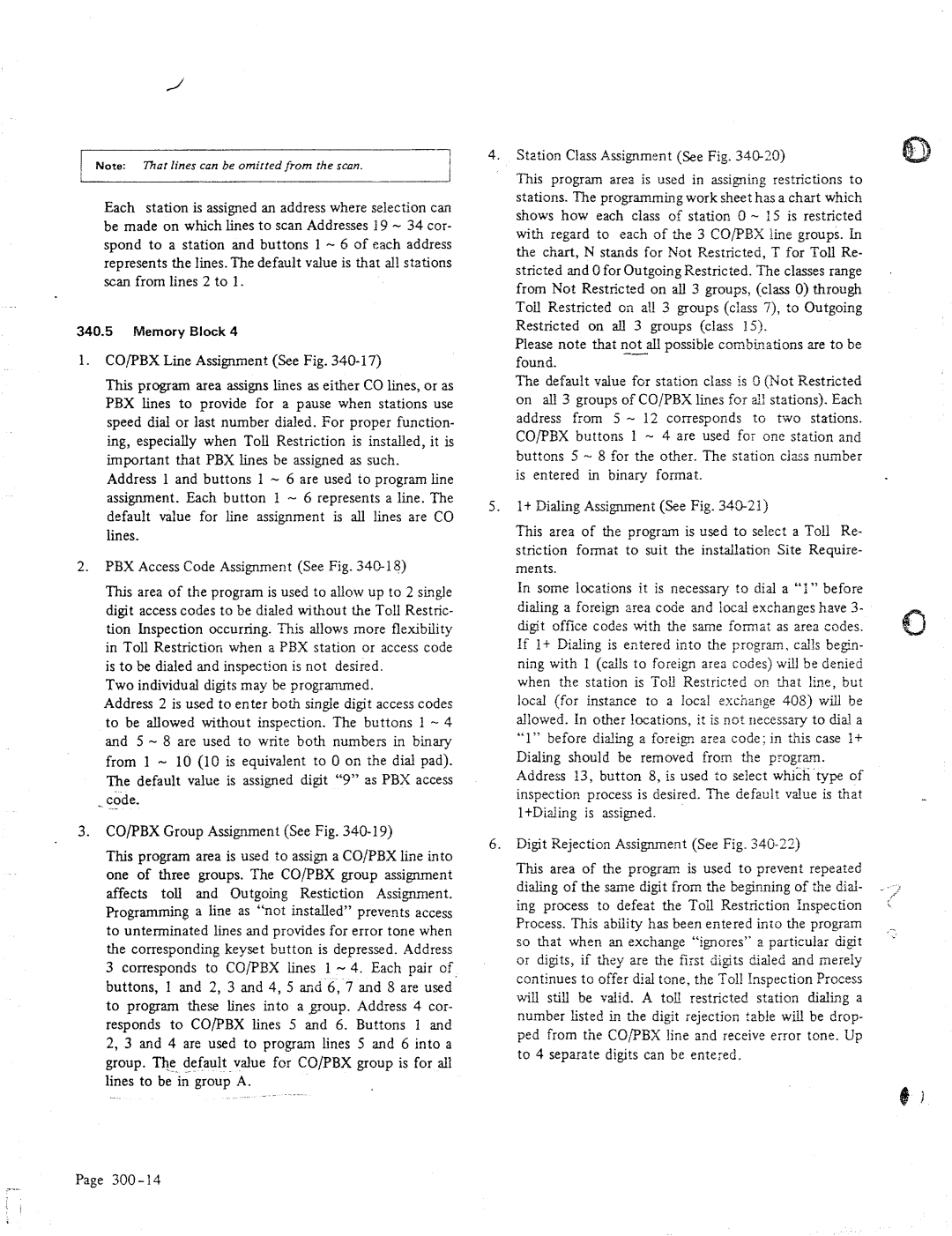
hklte: 77~1 lines cnn be omitted from fhe scm.
Each station is assigned an address where selection can be made on which lines to scan Addresses 19 - 34 cor- spond to a station and buttons 1 - 6 of each address represents the lines. The default value is that all stations scan from lines 2 to 1.
340.5Memory Block 4
1.CO/PSX Line Assignment (See Fig.
This program area assigns lines as either CO lines, or as PBX lines to provide for a pause when stations use speed dial or last number dialed. For proper function- ing, especially when TolI Restriction is installed, it is important that PBX lines be assigned as such.
Address 1 and buttons 1 - 6 are used to program line assignment. Each button I - 6 represents a line. The default value for line assignment is all lines are CO lines.
2.PBX Access Code Assignment (See Fig. 34Cl8)
This area of the program is used to allow up to 2 single digit access codes to be dialed without the Toll Restric- tion Inspection occurring. This allows more flexibility in Toll Restriction when a PBX station or access code is to be dialed and inspection is not desired.
Two individual digits may be programmed.
Address 2 is used to enter both single digit access codes to be allowed without inspection. The buttons 1 - 4 and 5 - 8 are used to write both numbers in binary
from 1 - IO (10 is equivalent to 0 on the dial pad). The default value is assigned digit “9” as PBX access
__code.
3.CO/PBX Group Assignment (See Fig.
This program area is used to assign a CO/PBX line into one of three groups. The CO!PBX group assignment
affects tolI and Outgoing Restiction Assignment. Programming a line as “not installed” prevents access
to unterminated lines and provides for error tone when the corresponding keyset button is depressed. Address
3 corresponds to CO/PBX lines 1 - 4. Each pair of. buttons, I and 2, 3 and 4, 5 and 6, 7 and 8 are used to program these lines into a group. Address 4 cor- responds to CO/PBX lines 5 and 6. Buttons I and 2, 3 and 4 are used to program lines 5 and 6 into a group. The. default value for CO/PBX group is for all lines to be in group A.
4.Station Class Assignment (See Fig.
This program area is used in assigning restfictions to stations. The programming work sheet has a chart which shows how each class of station 0 - 15 is restricted with regard to each of the 3 CO/PEX line groups. In the chart, N stands for Not Restricted, T for TolI Re- stricted and 0 for Outgoing Restricted. Tine classes range
from Not Restricted on all 3 groups, (class 0) through
Toll Restricted on all 3 groups (class 7), to Outgoing Restricted on all 3 groups (class 15).
Please note that not ah possible combinations are to be _-
found.
The default value for station class is 0 (Not Restricted on all 3 groups of CO/PBX lines for all stations). Each
address from 5 - 12 corresponds to swo stations. CO/PBX buttons 1 - 4 are used for one station and buttons 5 - 8 for the other. The station ciass number is entered in binary format.
5.lt Dialing Assignment (See Fig.
This area of the program is used to select a Toll Re- striction format to suit the installation Site Require- ments.
In some locations it is necessary to dial a “I” before dialing a foreign area code and local exchanges have 3- digit office codes with the same fomlat as area codes. If l+ Dialing is entered into the prograrr, calls begin- ning with 1 (c&s to foreign area codes) wi!l be denied when the station is Toll Restricted on that line, but local (for instance to a local exchange 408) will be allowed. In other Iocations, it is not necessary to dial a “1” before dialing a fore@ a:ea code; in this case I+ Dialing should be removed
Address 13, button 8, is used to select which type of inspection process is desired. The default value is that l+Dialing is assigned.
6.Digit Rejection Assignment (See Fig.
This area of the program is used to prevent repeated
dialing of the same digit from the beginning of the
ing process to defeat the Toll Restriction Inspection
Process. This ability has been entered into the program ,._
so that when an exchange “ignores” a particular digit _’ or digits, if they are the first digits dialed and rnerely continues to offer dial tone, the Toll Inspection Process
will still be valid. A toll restticted station dialing a number listed in the digit rejection table will be drop- ped from the CO/PBX line and receive error tone. Up to 4 separate digits can be entered.
Page
